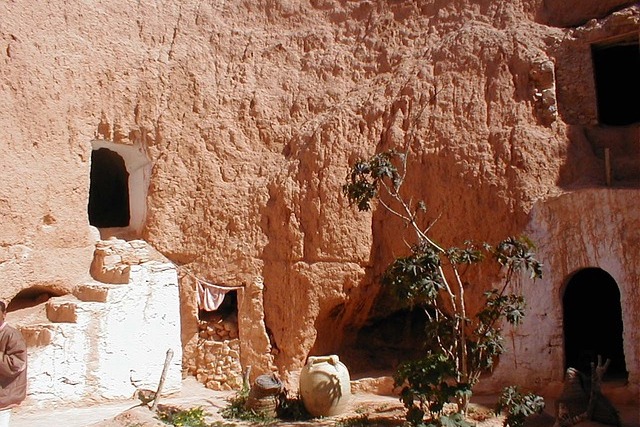Although no one likes the idea of going underground, cultures throughout history have experimented with the idea in one way or another. Even today, you can visit the remains of many fascinating underground cities and structures around the world, from the haunted crypts beneath Edinburgh to the vast network of catacombs beneath Odessa.
10. Underground houses of Matmata, Tunisia

Matmata - Berber-speaking a city in southern Tunisia famous for its unique underground houses carved into the hillside. Also known as troglodyte houses, they were originally built to provide protection from the region's harsh hot and cold seasons. However, many of them are now not used and are in need of renovation, while some have been converted into hotels or other tourist facilities. (In large part due to their use in "Star Wars" .) Although we do not know exactly when they were built, they may have appeared as early as the 11th century, when the first Berber-speaking population moved in and moved in . in the region.
The houses themselves are ingeniously built, with a network of tunnels connecting the various sections, such as the living room, kitchen and bedrooms. As well as providing protection from the elements, the fortified nature of the structures would also have protected against raiders and hostile states, as the Berbers were often persecuted by the more powerful Arab states in the region.
9. Vladivostok Fortress, Russia
Built in the 19th century as a Russian imperial base, Vladivostok is now a historical monument located in the Far East Primorsky Krai . It was one of the most impressive sea fortresses of its time, built primarily to defend against Japanese and other enemy attacks from the east. For a long time, the fortified city and its underground chambers housed the Imperial Russian Navy, making it a potential target in a major war.
Today, the network of underground tunnels and bunkers beneath the port city has been transformed into a cultural heritage site, including a museum. objects , which once belonged to the Imperial Pacific Fleet. In addition to cellars, passages and warehouses, the fortress also contains numerous bomb shelters and water tanks in case of a siege. Despite its age and wear, the fortress remains in relatively good condition, with much of its original structure still intact.
8. Mining town of Coober Pedy, Australia
The mining town of Coober Pedy in southern Australia was built in In 1915 after a young boy accidentally discovered large quantities of opals in the area. By 1920, it had grown into a small town as the first residents began living and working underground to escape the intense heat, building homes, churches, hotels and small businesses to support the settlement. As the demand for opals grew around the world, Coober Pedy soon became a thriving opal mining centre, with miners and mining companies from around the world flocking to the area to make their fortunes.
Coober Pedy is still a working opal mining town today, producing around 60% of the total 3500 inhabitants live underground. Despite the particularly harsh conditions region and limited natural resources, the city has managed to survive and over the years become a popular tourist destination.
7. Moose Jaw Tunnels, Canada
The Moose Jaw Tunnels in Saskatchewan, Canada, were built in the early 1900s when anti-Chinese hysteria was gaining momentum in Canada and the United States, a historical phenomenon we now know as the Yellow Peril. They were widely used to transport Chinese immigrants from the United States to Canada, as most of the entrances were hidden in the underground basements of legal Chinese migrants living above. Evidence suggests that these tunnels served as refuges for long periods of time and were often targeted by Canadian law enforcement agencies , which points to a dark but forgotten period in Canadian history.
By the 1920s, the tunnels were used to transport liquor and other illegal items during Canada's Prohibition era, as well as a variety of other criminal activities. They are now a popular tourist attraction throughout the year, and you can even visit and explore the structure on one of the many tours available in the city.
6. Derinkuyu, Türkiye
Derinkuyu was once a vast underground city in Turkey's historic Cappadocia province. It was built around the eighth century BC by the Phrygians, according to Turkey's Department of Culture. — representatives of the Indo-European culture that flourished in the Anatolian region around that time. The structure is more than 85 meters deep — or about 280 feet - in some places, with living quarters, stables, storage rooms and ventilation shafts.
Although the town had a population of over 20,000 at its peak during the Byzantine era, it fell into disuse some time after the Ottomans took over in the 15th century. It was rediscovered during an archaeological expedition in 1963 and eventually opened to tourists in 1965. According to some theories, Derinkuyu served as an important refuge for Christians persecuted during the early Islamic raids in the region.
5. Edinburgh Vaults, Scotland
Also sometimes referred to as the South Bridge Vaults, the Edinburgh Vaults are a series of underground chambers beneath the South Bridge in Edinburgh, Scotland. They were built around the same time as the bridge's construction in In 1788 , and were originally used as underground workshops and warehouses for the tradesmen working above.
As the city's population grew, the vaults became associated with the darker side of Edinburgh life, as they were soon inhabited by gamblers, bootleggers, murderers and other criminals. According to one rumour, they were home to two of the most notorious serial killers in Scottish history, William Burke and William Hare.
The vaults were actually closed by the end of the 19th century, but were rediscovered by a Scottish rugby player in the 1980s. They are now considered one of the most haunted places in Scotland, thanks to the many ghost sightings and other spooky phenomena reported in many of its vaults. 120 underground rooms for many years.
4. Wieliczka Salt Mine, Poland

Wieliczka is one of two salt mines located in the town of Wieliczka in southern Poland. It was built in 13th century , when salt became an expensive and sought-after commodity worldwide, and has been in continuous operation ever since. The mine has since been expanded and excavated by generations of miners, with a network of underground chambers, halls and passages spread across nine levels.
In addition to being a working salt mine and one of the first centers of industrial activity in Europe, it is also a cultural and historical site called the Wieliczka Salt Mine City. 19th century The entire structure was transformed into a giant art exhibit, with salt-carved monuments, crystal chandeliers, ornate chapels and other artifacts scattered throughout it. 2400 cameras.
3. Nuclear bunkers in Berlin, Germany
Berlin has been home to an extensive network of underground bunkers since at least the 1950s, when hardened underground structures became a popular, if untested, defense against nuclear weapons. Although most were built as Cold War shelters, Berlin’s underground bunkers were surprisingly diverse, ranging from simple shelters to elaborate living quarters equipped with gas masks and other emergency survival equipment.
When cold war came to an end with the fall of the Berlin Wall in 1989 , most of these bunkers were abandoned or over the years converted into museums and art exhibition centers. In one of these spaces You can still encounter the city's underground musical stage, as many of them have been reopened and repurposed as live music venues in recent years.
2. Catacombs of Odessa, Ukraine
The city of Odessa in Ukraine boasts the most big network of catacombs in the world, totaling around 1,500 miles or 2,500 kilometers. Originally the result of extensive limestone mining in the city in the 1600s, it is now an entire underground city in itself, with over 1,000 known entrances and many chambers and passages to explore. Of course, you'd have to be particularly brave to do so, as these catacombs have been used for some pretty dark purposes over the years.
During World War II, the labyrinth was used as a hideout by occupying Nazi forces and can probably still be found bones and other relics of war if you explore the more remote parts of the structure. They were also used as shelters during air raids and as hidden smuggling routes in Soviet times.
1. Underground Great Wall, China
In the 1960s and 70s, Chairman Mao ordered the construction of thousands of underground shelters and settlements across China due to the growing threat of nuclear war around the world. In Beijing alone, more than 10,000 shelters were built to protect the capital's growing urban population.
Because of its vastness and military purposes, the entire structure, which once covered an area of over 85 square kilometers, or about 33 square miles, is sometimes referred to as the Great Underground Wall. The network reportedly included schools, movie theaters, barber shops, restaurants , shops, factories, ammunition depots , fortified bunkers and pretty much everything else needed to live underground for an extended period of time. Some parts were privatized and sold to smaller homeowners, who then eventually turned into tiny homes. Today people live or work in the underground city moremillion Human.













Оставить Комментарий